Jul 31, 2025
5 min read
Suno vs Udio: Two AI music giants—but which one actually fits your workflow?
This blog breaks down their features, sound quality, pricing, and use cases to help you decide which tool is best for your music creation needs.

- 1. Music Creation Workflow – How They Work
- 2. Music Quality – Which Sounds More Professional?
- 3. Pricing & Commercial Use – What's Free and What's Not?
- 4. Use Cases – Which Tool Works Best for Your Needs?
- 5. Pros and Cons Based on User Feedback
 Part 4. FAQs – Suno vs Udio
Part 4. FAQs – Suno vs Udio
Part 1. Suno vs Udio: Which AI Music Generator Fits You Best?
When it comes to AI music generators, Suno and Udio are currently leading the conversation.
Both platforms let you create full songs with vocals using nothing more than text prompts or audio input—but they take slightly different approaches.
Suno focuses on speed and simplicity. Its interface is designed for users who want quick, radio-ready tracks with minimal input. You can type a short idea or upload a vocal hum, and Suno delivers a full vocal song within seconds.
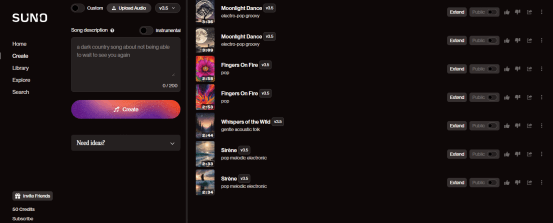
It supports:
● Simple Mode for automatic full-song generation
● Custom Mode for lyrics, genre, and stylistic input
● Audio Upload for humming or demo clips
In benchmark tests from April 2025, Suno generated the most commercially viable complete songs with minimal editing required.
Udio, on the other hand, is built for creators who want more control and depth. While it may take longer to generate, Udio supports:
● Flexible length(extendable clips and up to 15 minutes with continuation)
● More complex musical arrangements
● Style reference and mood settings
● Audio uploads and detailed lyric/prompt input
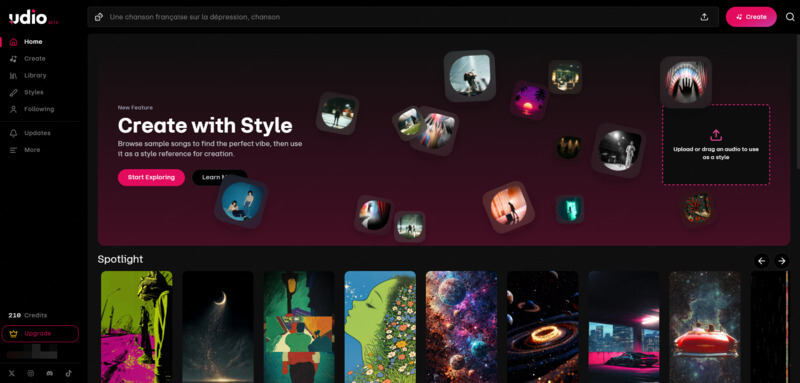
Quick Tip
● Use Suno for speed and catchy vocal tracks.
● Use Udio for structured compositions and professional-grade audio.
Part 2. Suno vs Udio Feature Comparison
1. Music Creation Workflow – How They Work
Suno offers two core creation modes: Simple and Custom.
● In Simple Mode, you can enter a short text or upload audio; get a full vocal track in ~30 seconds.
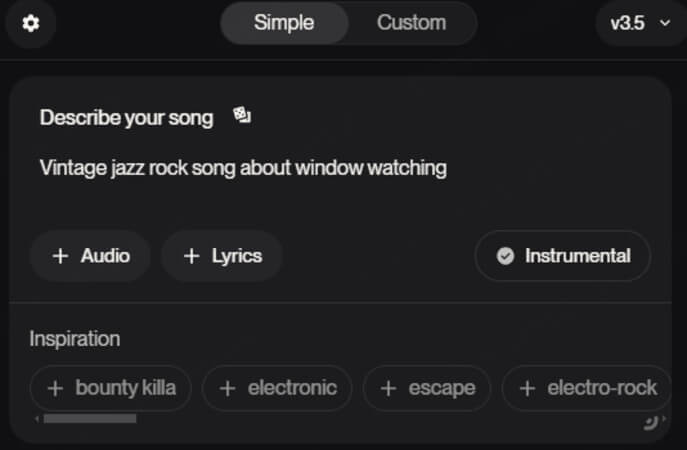
● In Custom Mode, you have more creative control. You can write lyrics, select genres, and exclude styles to shape the output.
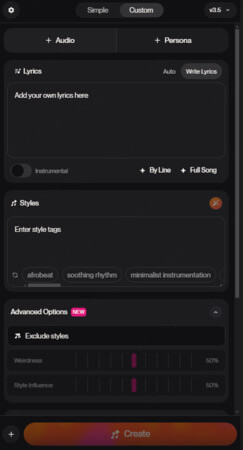
In addition to generation, Suno offers several tools to help refine your music:
● Personas – apply the same vocal tone or singing style across multiple songs
● Remaster – improve audio clarity and polish with one click
● Cover - change the style of the song
● Export Options: MP3 and WAV formats with commercial licensing on paid plans
Suno's Workflow Philosophy: From idea to finished track in minutes, zero production experience required.
Udio supports two core creation modes: Describe Your Song and Use a Style. Both allow you to upload audio clips and combine them with prompts or lyrics to guide the creation.
● In Describe Your Song, you can use prompts, upload audio, add lyrics, and define genre/mood.
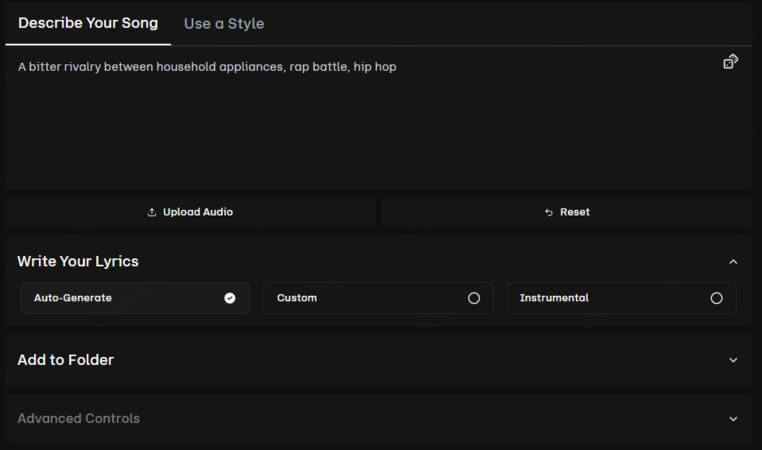
● In Use a Style, you start from reference tracks(Udio sample, your own audio, or others).
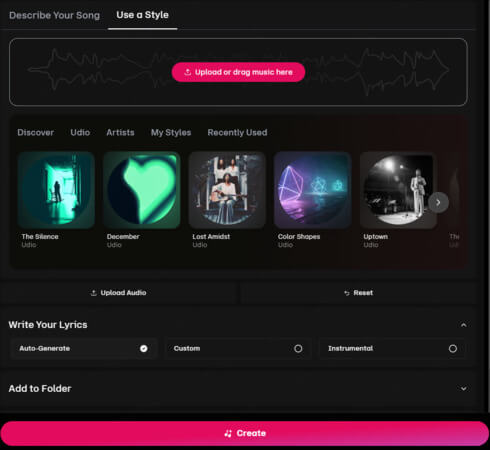
One of Udio's standout features is Advanced Controls, which let you fine-tune how songs are generated:
● AI model choices(V1.0, V1.5, V1.5 Allegro)
● Adjustable track length(32s–2:10, extendable)
● Precise lyric timing, BPM, and prompt strength
● Clip continuation and seed value for reproducibility
Udio's Workflow Philosophy: Maximum creative control for users who want to shape every aspect of their music.
✅ Summary: If your goal is to create songs quickly with minimal input, Suno offers a faster and more streamlined experience out-of-the-box. But if you want more control over the style, structure, or AI interpretation of your music, Udio gives you the tools to shape the output precisely to your vision.
2. Music Quality – Which Sounds More Professional?
Suno: Polished Pop Production
Pros
✅ Expressive vocals that sound almost human
✅ Great for pop, hip-hop, EDM, and lo-fi
✅ Clean, ready-to-use mixing
✅ Consistent results across prompts
✅ Optimised for viral, short-form content
Cons
❌ Can sound templated or repetitive
❌ Lacks depth in instrumentation
❌ Less nuance and musical variation
❌ Similar structure across different songs
Suno's Quality Sweet Spot: Short-form, vocal-driven content that needs immediate impact and minimal post-production.
Udio: Studio-Grade Depth and Realism
Pros
✅ Studio-quality audio output
✅ Rich instrumentation with wide stereo depth
✅ Smarter chord progressions and transitions
✅ Works well across blended or experimental genres
✅ Feels more emotional and immersive
Cons
❌ Vocals may feel less powerful than Suno
❌ Takes longer to generate high-quality output
❌ More complex for casual users
Udio's Quality Sweet Spot: Extended compositions requiring professional production values and musical complexity.
✅ Summary
● If you're creating short-form content, need standout vocals, or want instant results with strong genre clarity, Suno will likely impress you.
● But if your focus is on production quality, musical texture, or extended compositions that feel more "studio-grade," Udio offers a more detailed and studio-like sound.
3. Pricing & Commercial Use – What's Free and What's Not?

Suno Pricing Overview
Suno offers three subscription tiers, each with varying limits and access to features:
● Free: 50 credits/day(~10 songs), no commercial rights
● Pro($10/mo): 2,500 credits/month, access to v4.5+, longer uploads, stem editing, commercial use
● Premier($30/mo): 10,000 credits, batch gen, faster queues, all features
Good for: Fast song creation with vocals and post-editing—if you're willing to pay for it.
Udio Pricing Overview
Udio also offers three pricing tiers that scale based on your creative needs:
● Free: 10 credits/day, 100 bonus/month, 3 full tracks/day, no card required
● Standard($10/mo): 1,200 monthly tracks, 6-song batch, stem/audio-to-song/custom cover tools
● Pro($30/mo): 4,800 tracks/month, 8-song batch, reference-style gen, batch download
Good for: Users who want flexibility, audio input, remix options, and fewer free-tier limits.
Verdict: If you're looking for a fast, polished, plug-and-play music generator, Suno offers good value—but only when paid.
Udio, on the other hand, gives you more freedom out of the box, better remixing and uploading tools, and fewer restrictions on usage—making it a better long-term option for creators who want flexibility without paying upfront.
4. Use Cases – Which Tool Works Best for Your Needs?
While both Suno and Udio are powerful AI music tools, they shine in different use cases depending on your creative goals and workflow preferences.
Suno excels at:
● Quick, social-media-ready tracks
● Beginners or non-musicians with lyric ideas
● Fast demos or lyric-to-melody conversion
Udio excels at:
● Multi-part, longer music pieces
● Experimental or cross-genre music
● Audio-guided composition and remixing
● Integration with DAWs via stems and BPM tools
✅ Summary:
Need fast vocals and short catchy songs? Go with Suno.
Want deeper structure, remix control, or more musical complexity? Try Udio.
5. Pros and Cons Based on User Feedback
To better understand each platform's strengths and weaknesses, we examined user feedback from Reddit and music production communities. Here's what real users are saying.
Suno – What Users Love
● Speed and polish: Users praise how quickly Suno can turn a prompt into a catchy, full vocal track. It's especially strong for mainstream pop and EDM.
● Ease of use: The simple UI and fast turnaround time are ideal for beginners or creators without technical music skills.
● Creative improvement: Recent updates(v4.5) have made Suno's music more expressive and usable for casual releases.
"Suno's music right now is surprisingly creative. The stems were almost too artifact-ish to mix, but the result is pleasant enough for Spotify."
— Reddit user
Note: These are selected user opinions—individual experiences may vary.
Suno – Common Complaints
● Sound artifacts: Some users notice compression issues or vocal glitches, especially after repeated listening.
● Lyrics mismatch: Issues like mid-verse cutoffs, mismatched vocal gender, or incomplete choruses are frequently mentioned.
● No prompt tuning: Once generated, there's no way to tweak the result without starting over—and that costs credits.
Udio – What Users Love
● Creative depth: Many users feel Udio's output sounds more artistic and original, especially in non-mainstream genres.
● Structural flexibility: The ability to extend songs, use multiple sections, and refine prompts gives creators more long-term value.
● Commercial-ready: Even the free plan allows for commercial use, which is a big advantage for indie musicians and producers.
Udio – Common Complaints
● Prompt inconsistency: Several users report that Udio often ignores detailed prompts—sometimes even changing genre or generating lyrics in the wrong language.
● Lack of predictability: Udio can produce stunning results, but it also occasionally fails in surprising ways, making it harder to get exactly what you intended.
● Learning curve: Because of the advanced settings, Udio may feel overwhelming for new users compared to Suno.
"I gave it an English prompt and lyrics, and it generated Japanese vocals with a totally unrelated genre… Udio is just living its own life."
— Reddit user
"It feels like you're gambling. You click generate hoping for magic, but if the results aren't what you expected, you burn more credits and try again."
— Reddit user
Disclaimer: User feedback is subjective and may differ by use case.
Part 3. Bonus: Looking for More Control or Speed?
Suno delivers speed. Udio focuses on quality. But if you need longer songs, custom styles, or even MIDI exports for deeper control, Musicful might be the better fit.
It is a browser-based AI music tool that turns lyrics, text prompts, or audio into complete songs—with support for up to 8-minute compositions, 5,000-character lyrics, and even WAV + MIDI export.
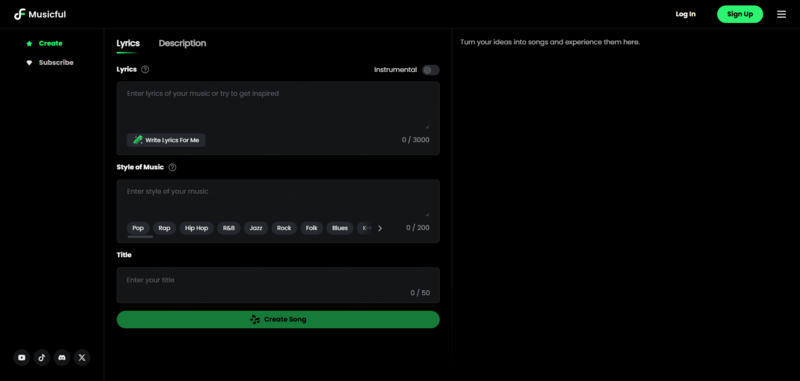
Its "Add Vibe" tool lets you mimic the rhythm and mood of any reference track, ideal for creators who want to explore or remix freely.
Key Features
⭐ Text-to-music and audio-to-music generation
⭐ "Add Vibe" to match the feel of any track
⭐ Up to 8-minute songs and 5,000-character lyrics
⭐ Browser-based, fast, and installation-free
⭐ WAV export + user song discovery and remix options
If Suno and Udio feel limiting, a tool like Musicful can help you explore more ideas—and more creative freedom.
Part 4. FAQs – Suno vs Udio
1. Which is better, Suno or Udio?
It depends. Suno is faster and more beginner-friendly; Udio offers more structure and better audio fidelity.
2. Is Suno trustworthy?
Yes, but be aware: while Suno allows commercial use on paid plans, it doesn't provide copyright proof documents, which may be a concern for some use cases.
3. Are there other AI music tools besides Suno and Udio?
Yes—platforms like Musicful support both vocal and instrumental creation with more flexibility in input methods, structure, and song length.
4. Can I use these tools for commercial music releases?
Udio allows commercial use even on its free tier. Suno requires a paid subscription, and copyright ownership may not be fully documented.
5. Can I use both Suno and Udio together in my workflow?
Yes. Many creators use Suno for fast drafting and Udio for refined production. Combining tools can help maximise both speed and control.
Conclusion
When comparing Suno vs Udio, there's no absolute winner. Many creators use both—starting with Suno for quick drafts, then refining with Udio's tools.
If you want even more flexibility, try Musicful for longer tracks, vibe-matching, and full control over structure.
CREATE SONG NOW

